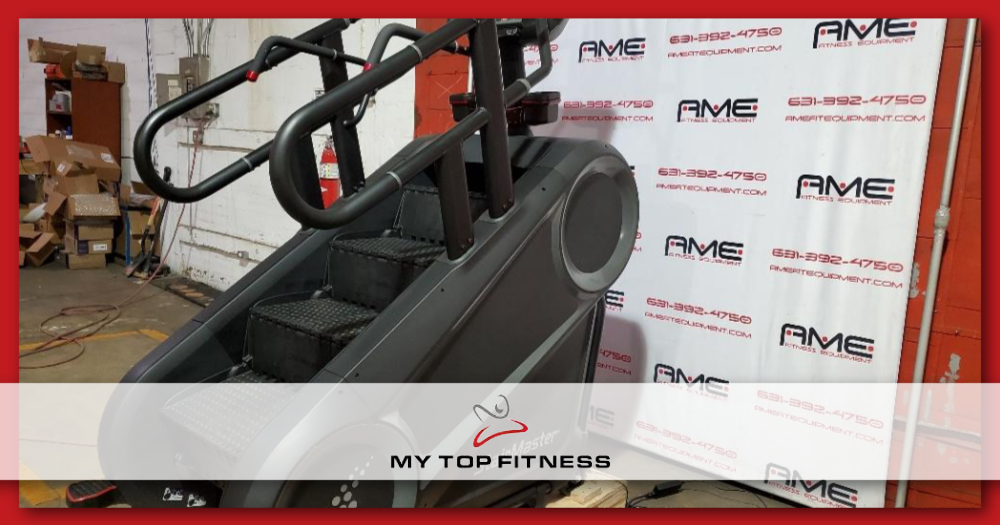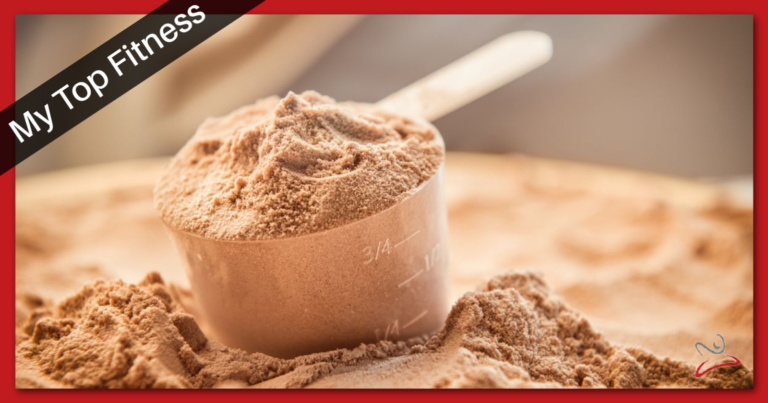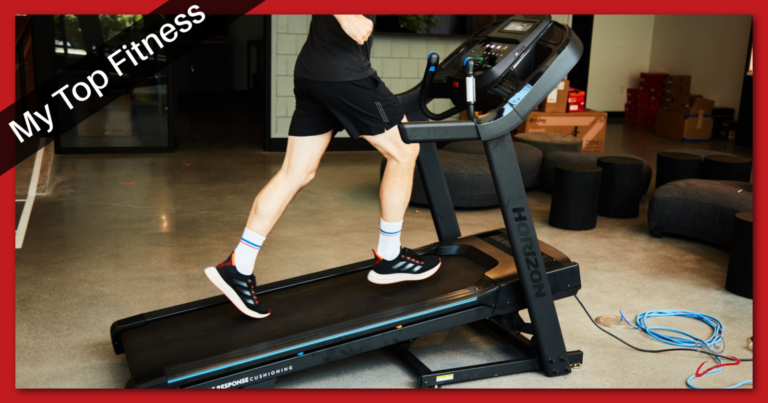How Long Does It Take to Climb 100 Floors on StairMaster? A Definitive Answer

If you are looking for a challenging cardio workout, climbing 100 floors on a Stairmaster is a great option. Not only does it provide a great cardiovascular workout, but it also helps to tone and strengthen your lower body muscles. However, you may be wondering how long it takes to climb 100 floors on a Stairmaster and what physical requirements and fitness levels are necessary to achieve this feat. Let’s dive right in!
Understanding Stairmaster Workouts
If you’re looking to improve your cardiovascular fitness, the Stairmaster is an excellent piece of equipment to use. Understanding these workouts is key to knowing how to climb 100 floors. The Stairmaster is designed to provide a high-intensity cardiovascular workout that targets the lower body muscles. To climb 100 floors on a Stairmaster, you need to have a good understanding of how the machine works and how to use it effectively.
When using the Stairmaster, you can choose from a variety of settings to customize your workout. You can adjust the speed, resistance, and incline to create a workout that’s challenging and effective.
One of the key benefits of using the Stairmaster is that it’s a low-impact exercise. This means that it’s easier on your joints than other forms of cardio, such as running. This makes it a great option for people who have knee or ankle problems.
To get the most out of your Stairmaster workout, it’s important to use proper form. Make sure that you’re standing up straight and not leaning on the handrails. This will engage your core muscles and make the workout more challenging.
If you’re new to using the Stairmaster, it’s a good idea to start with a shorter workout and gradually increase the duration and intensity over time. This will help prevent injury and ensure that you’re getting the most out of your workout.
The Challenge of 100 Floors
Climbing 100 floors on a stairmaster is a challenging goal that requires endurance, strength, and mental toughness. It may seem daunting at first, but with the right mindset and approach, you can conquer this feat and feel proud of your accomplishment.
To complete the 100-floor challenge, you need to climb a total of 1,600 steps, assuming each flight of stairs has 16 steps. Depending on your fitness level and pace, this can take anywhere from 15 minutes to an hour or more. The world’s fastest climbers can complete the challenge in as little as 8 minutes, but most people take between 20 and 30 minutes to reach the top.
To prepare for the challenge, it’s essential to train your cardiovascular system, leg muscles, and mental stamina. You can do this by incorporating stair climbing into your workout routine, gradually increasing the intensity and duration of your sessions. You can also try interval training, where you alternate between periods of high-intensity climbing and rest.
When you start the challenge, pace yourself and take breaks as needed. It’s better to climb slowly and steadily than to burn out early and struggle to finish. You can also use visualization techniques to stay motivated and focused, such as imagining yourself reaching the top of each flight of stairs or picturing a reward waiting for you at the finish line.
Overall, climbing 100 floors on a stairmaster is a challenging but achievable goal that can help you improve your fitness and mental toughness. With the right preparation, mindset, and approach, you can conquer this challenge and feel proud of your accomplishment.
Physical Requirements and Fitness Level
Before attempting to climb 100 floors on a StairMaster, it is important to assess your physical requirements and fitness level. This is a challenging workout that requires a certain level of endurance and fitness. Here are some factors to consider:
Fitness Level
To successfully climb 100 floors on a StairMaster, you need to be in good physical shape. This means having a good level of cardiovascular fitness, endurance, and muscle strength. If you are new to exercise, it is recommended that you start with shorter workouts and gradually build up to longer sessions.
Endurance
Endurance is essential for climbing 100 floors on a StairMaster. You need to be able to sustain a high level of effort for an extended period of time. This means training your cardiovascular system to work efficiently and effectively. You can improve your endurance by doing activities such as jogging, cycling, or swimming.
Major Muscle Groups
Climbing 100 floors on a StairMaster requires the use of several major muscle groups, including your quadriceps, hamstrings, glutes, and calves. It is important to ensure that these muscles are strong and well-conditioned to avoid injury and fatigue during your workout. You can strengthen these muscles by doing exercises such as squats, lunges, and calf raises.
Muscle Mass
Having a good amount of muscle mass can also be beneficial for climbing 100 floors on a StairMaster. This is because muscle tissue burns more calories than fat tissue, which means that having more muscle can help you to burn more calories during your workout. You can increase your muscle mass by doing resistance training exercises such as weight lifting or using resistance bands.
The Role of Pace and Intensity
When it comes to climbing 100 floors on a StairMaster, the role of pace and intensity cannot be overstated. Both factors play a significant role in determining how long it will take you to complete the challenge.
Pace refers to the speed at which you climb the stairs. If you are walking, your pace will be slower than if you are running or sprinting. The faster your pace, the quicker you will reach the top. However, it is important to note that maintaining a fast pace for an extended period can be challenging and may lead to fatigue.
Intensity level refers to the level of effort required to climb the stairs. The higher the intensity level, the more calories you will burn and the more quickly you will reach the top. However, it is important to find a balance between intensity and pace to avoid overexertion.
If you are walking, it will take you longer to climb 100 floors than if you are running or sprinting. However, walking is a great way to build endurance and can be an effective way to complete the challenge for those who are new to StairMaster workouts.
Benefits of Climbing Stairs
When it comes to getting in shape, climbing stairs is one of the best exercises you can do. It’s a great way to get your heart rate up and burn calories, making it an ideal choice for weight loss. But the benefits of climbing stairs go beyond just weight loss. Here are some of the top benefits of this aerobic activity:
-
Improves cardiovascular health: Climbing stairs is an excellent way to improve your cardiovascular health. It gets your heart pumping and increases blood flow throughout your body, which can help reduce your risk of heart disease.
-
Builds muscle: Climbing stairs is a great way to build muscle in your legs, glutes, and core. It’s a low-impact exercise that can help you tone and strengthen your muscles without putting too much strain on your joints.
-
Burns calories: Climbing stairs is a high-intensity exercise that burns a lot of calories. In fact, climbing stairs for just 30 minutes can burn up to 500 calories, making it a great choice for weight loss.
-
Improves balance and coordination: Climbing stairs requires balance and coordination, which can help improve your overall fitness and reduce your risk of falls.
-
Boosts mood: Exercise is known to boost mood and reduce stress, and climbing stairs is no exception. It releases endorphins, which can help you feel happier and more relaxed.

Calories Burned and Weight Loss
Climbing stairs is an excellent way to burn calories and lose weight. According to the search results, the number of calories burned while climbing stairs depends on your weight, speed on the stairs, and the load you are carrying. The heavier you are, the more calories you will burn while climbing stairs.
Using a calories burned calculator can help you estimate the number of calories you will burn while climbing stairs. The calculator uses your weight, the duration of the activity, and the intensity of the activity to estimate the number of calories burned.
For example, if you weigh 150 pounds and climb stairs for 30 minutes, you can burn approximately 225 calories. This is a significant amount of calories burned in just 30 minutes, which can help you lose weight over time.
It is important to note that weight loss is not just about burning calories. You also need to maintain a healthy diet and lifestyle to see significant weight loss results. However, incorporating stair climbing into your exercise routine can be an effective way to burn calories and support your weight loss goals.
In addition to weight loss benefits, climbing stairs can also provide cardiovascular benefits, improve muscle strength and endurance, and boost your overall fitness level. So, if you’re looking for an efficient way to burn calories and improve your health, consider adding stair climbing to your exercise routine.
Muscles Worked During the Climb
When you climb 100 floors on a StairMaster, you engage a variety of muscles in your lower body. Here are the main muscles that you work during the climb:
-
Glutes: The gluteus maximus is the largest muscle in your gluteal muscle group, and it is the primary hip extensor. When you climb stairs, your glutes work to lift your body as you press downward with one leg at a time.
-
Hamstrings: The hamstrings are a group of three muscles that run along the back of your thigh. They work to bend your knee and extend your hip, which is important when you climb stairs.
-
Calves: The calves are made up of two muscles, the gastrocnemius and the soleus. They work to plantarflex your ankle, which means they help you push off the ground when you step up on the StairMaster.
-
Quads: The quads are a group of four muscles that run along the front of your thigh. They work to straighten your knee and lift your leg, which is important when you step up on the StairMaster.
Adapting the Workout to Home or Gym
If you’re interested in trying the 100-floor challenge on a StairMaster, you may be wondering whether you can do it at home or if you need access to a gym. The good news is that you can adapt the workout to either setting.
Home Workouts
If you have a StairMaster at home, you’re all set to try the 100-floor challenge. If you don’t have a StairMaster, you can still work out your legs and cardiovascular system with bodyweight exercises or other equipment. Here are some ideas:
- Bodyweight lunges and squats
- Step-ups onto a sturdy chair or bench
- Running up and down stairs in your house or apartment building
- Jumping jacks or other high-intensity cardio exercises
Gym Workouts
If you prefer to work out at a gym, you’ll have access to a StairMaster and other equipment that can help you achieve your fitness goals. Here are some tips for adapting the 100-floor challenge to a gym setting:
- Use a StairMaster that has a high step rate and a challenging resistance level
- Incorporate other equipment, such as weights or resistance bands, to add intensity and variety to your workout
- Take advantage of group fitness classes, such as step aerobics or boot camp, to keep your workouts interesting and challenging
Whether you’re working out at home or at the gym, it’s important to stay motivated and focused on your goals. Consider setting a timer or using a fitness app to track your progress and help you stay on track. With dedication and consistency, you can conquer the 100-floor challenge and achieve your fitness goals.
Progress and Goal Setting
Setting goals and tracking your progress is essential to achieving success in any fitness routine. When it comes to climbing 100 floors on the Stairmaster, it’s important to set realistic goals and track your progress to stay motivated and on track.
Start by setting a goal for the number of floors you want to climb in a set amount of time, such as 30 minutes or an hour. Keep in mind that the average person climbs about 10-12 floors per minute on the Stairmaster, so climbing 100 floors would take approximately 8-10 minutes.
To make your goal more challenging, consider increasing the intensity level on the Stairmaster or increasing the number of floors you want to climb. However, it’s important to avoid setting unrealistic goals that could lead to injury or burnout.
Tracking your progress is also important for staying motivated and on track. Consider using a fitness tracker or app to monitor the number of floors you climb and the amount of time it takes. This can help you see your progress over time and make adjustments to your routine as needed.
Remember to celebrate your progress and accomplishments along the way. Whether it’s reaching a new milestone or simply sticking to your routine, every step counts towards your overall goal of climbing 100 floors on the Stairmaster.
Preventing Health Risks
Climbing 100 floors on a StairMaster is a challenging task that requires a lot of physical effort. While it can be a great way to improve your physical fitness and stamina, it can also pose some health risks if not done correctly. In this section, we will discuss some tips to help you prevent health risks while climbing 100 floors on a StairMaster.
Warm-Up and Cool-Down
Before you start climbing, it is important to warm up your muscles to prevent injury. You can start with a few minutes of light cardio exercise, such as walking or jogging, to get your blood flowing and your muscles warmed up. Once you are warmed up, you can start climbing.
After you have completed your climb, it is important to cool down your muscles to prevent injury and reduce soreness. You can do some light stretching exercises to help your muscles recover.
Monitor Your Heart Rate
Climbing 100 floors on a StairMaster can be an intense workout that can increase your heart rate. It is important to monitor your heart rate during your climb to make sure that you are not overexerting yourself. You can use a heart rate monitor or simply check your pulse to make sure that your heart rate is within a safe range.
Use Proper Form
Using proper form when climbing on a StairMaster is important to prevent injury and maximize the benefits of your workout. Make sure that you are standing up straight and not hunching over. Keep your shoulders relaxed and your arms at your sides. Avoid leaning on the handrails, as this can put unnecessary stress on your shoulders and back.
Use Resistance
Using resistance when climbing on a StairMaster can help you build strength and endurance. However, it is important to use the right amount of resistance for your fitness level. Start with a lower resistance and gradually increase it as you get stronger.
Consult Your Doctor
If you have any pre-existing health conditions, such as heart disease or stroke, it is important to consult your doctor before starting a new exercise routine. Your doctor can help you determine if climbing 100 floors on a StairMaster is safe for you and provide you with any necessary precautions.
By following these tips, you can prevent health risks and get the most out of your StairMaster workout.
The Comparison: Stairmaster Vs Walking
When it comes to cardio workouts, there are several options to choose from. Two popular choices are the Stairmaster and walking. Both of these exercises can help you burn calories and improve your fitness level. Here’s a comparison of the two:
When it comes to burning calories, both the Stairmaster and walking can be effective. However, the number of calories you burn will depend on several factors, including your weight, intensity level, and duration of the workout.
According to a study by the American Council on Exercise, a 150-pound person can burn about 10 calories per minute on the Stairmaster. This means that it would take approximately 10 minutes to climb 100 floors. On the other hand, walking at a brisk pace can burn about 4-5 calories per minute. This means that it would take approximately 40-50 minutes of walking to burn the same number of calories.
In terms of steps, climbing 100 floors on the Stairmaster would be equivalent to about 1,500-2,000 steps. Walking 100 floors would be equivalent to about 2,000-2,500 steps.
Overall, both the Stairmaster and walking can be effective forms of exercise. The Stairmaster provides a low-impact workout and can help build strength, while walking is a weight-bearing exercise that can improve bone density. The choice between the two will depend on your personal preference and fitness goals.
Understanding Measurements and Distances
When it comes to measuring distances, it’s important to understand the units of measurement that are commonly used. This will help you to better understand how long it will take you to climb 100 floors on a StairMaster.
Feet and Miles
Feet and miles are two of the most common units of measurement used to measure distances. One mile is equal to 5,280 feet. This means that if you climb 100 floors on a StairMaster, you will have climbed approximately 1,320 feet.
Step Length
Step length is another important factor to consider when measuring distances. The average step length for an adult is 2.5 feet. This means that if you take 2 steps to climb one floor on a StairMaster, you will have climbed approximately 5 feet.
Levels
Some people may use the term “level” when referring to climbing stairs or using a StairMaster. It’s important to note that there is no standard definition of a “level”. In general, a level is considered to be a set of stairs that leads to a landing or a floor.
Time
The time it takes to climb 100 floors on a StairMaster will vary depending on your fitness level and the intensity of your workout. On average, it takes about 30-40 minutes to climb 100 floors on a StairMaster. However, this can vary depending on your individual circumstances.

Frequently Asked Questions
What’s the average time to climb 100 floors on StairMaster?
The time it takes to climb 100 floors on StairMaster can vary depending on factors such as your fitness level, the intensity level you choose, and the speed at which you climb. On average, it can take anywhere from 30 to 45 minutes to climb 100 floors on StairMaster.
How many steps are needed to climb 100 floors on StairMaster?
Most StairMasters count one floor as 16 steps. Therefore, to climb 100 floors on StairMaster, you would need to climb a total of 1,600 steps.
Is it possible to climb 100 floors on StairMaster in 20 minutes?
Climbing 100 floors on StairMaster in 20 minutes would require you to climb at an incredibly high speed. It’s not impossible, but it’s also not a realistic goal for most people. It’s important to set realistic goals and work towards them gradually to avoid injury.
How does climbing 100 floors on StairMaster compare to elevation gain?
Climbing 100 floors on StairMaster is equivalent to climbing approximately 1,600 feet of elevation gain. However, it’s important to note that StairMaster climbing is a low-impact exercise, whereas climbing actual stairs or hills would be higher impact and require more muscle engagement.
How long does it take to climb 110 floors on StairMaster?
Assuming an average time of 30 to 45 minutes to climb 100 floors, it would take approximately 33 to 50 minutes to climb 110 floors on StairMaster.
What’s the difference between climbing 100 floors and 100 flights on StairMaster?
There is no difference between climbing 100 floors and 100 flights on StairMaster. Both terms refer to climbing the equivalent of 100 floors on the machine.






